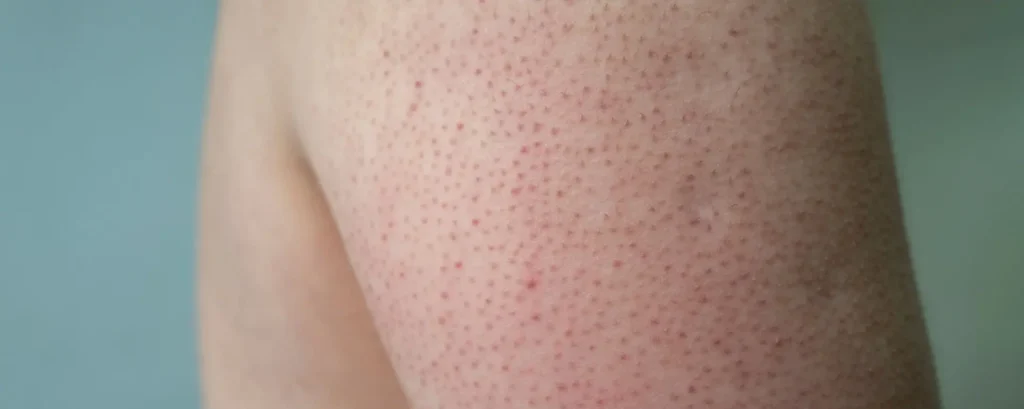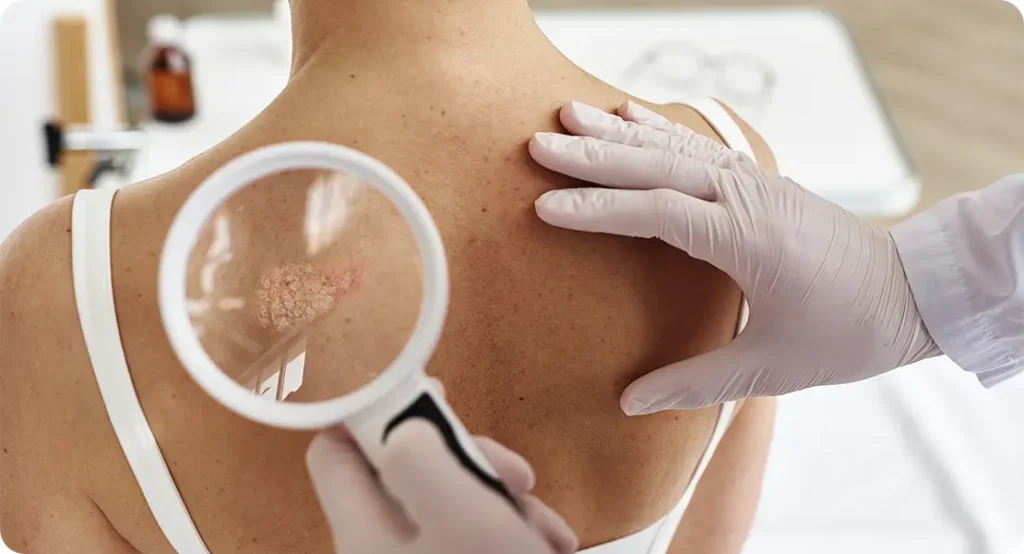Have you ever noticed tiny, rough bumps on your upper arms, thighs, buttocks, or even your cheeks? Do they resemble goosebumps, sandpaper, or what’s often described as “chicken skin”? If so, you’re probably dealing with a common skin condition known as keratosis pilaris a harmless yet often stubborn issue that can affect both how your skin feels and how it looks.
While it’s not dangerous or contagious, keratosis pilaris can be a source of ongoing frustration, especially when it doesn’t respond to your usual skincare products. The condition affects as many as 1 in 3 people, yet many individuals have never heard of it, or they mistake it for dry skin, acne, or even a rash. It’s particularly common in teens and young adults, but it can occur at any age and often gets worse in winter or in people with already dry or sensitive skin.
In this guide, I’ll explain what keratosis pilaris is, what causes those tiny bumps, and how to tell if you really have it (hint: it’s not always just about the look). Most importantly, you’ll learn about the best treatments available, including dermatologist-approved solutions and simple habits that can help soften and smooth your skin over time.
Whether you’re struggling with KP yourself or just curious about those persistent little bumps, this guide will help you understand the condition and what you can realistically do about it.
What Is Keratosis Pilaris?
Keratosis pilaris (often abbreviated as KP) is a very common and completely harmless genetic skin condition that tends to appear as tiny, rough bumps on the surface of the skin. It’s sometimes mistaken for acne, a rash, or simply “dry skin,” but it has a unique cause and appearance all its own.
At the root of the condition is keratin a naturally occurring protein that plays an important role in protecting your skin from harmful environmental factors, like bacteria and physical damage. In people with keratosis pilaris, the body produces too much keratin, which doesn’t shed from the skin as it should. Instead, this excess keratin builds up and forms hard plugs that block the openings of hair follicles (also known as pores).
These plugs are what create the signature tiny, sandpaper-like bumps you may feel or see on your skin. The bumps are usually flesh-toned, white, or red and are often surrounded by areas of dryness, flakiness, or slight redness. In some cases, the skin may also appear slightly inflamed, especially if the bumps are irritated from scratching or rubbing.
While KP is not painful and doesn’t pose any medical risk, it can be frustrating especially when it affects visible areas like the upper arms, thighs, cheeks, or buttocks. It’s most common in children and adolescents but can persist well into adulthood or appear for the first time later in life.
Though there’s no known “cure,” understanding how KP works is the first step to managing it effectively and in many cases, a targeted skincare routine can make a big difference in how your skin looks and feels over time.
What Does Keratosis Pilaris Look Like?

Keratosis pilaris is often mistaken for other common skin conditions like acne, eczema, or simply very dry skin and understandably so. At first glance, it can resemble small pimples or a mild rash, but there are a few distinctive signs that help set it apart.
Here’s what you’re likely to notice if you have KP:
- Tiny, rough bumps that feel like sandpaper or resemble goosebumps
- Bumps are typically flesh-coloured, white, or red, depending on your skin tone and whether there’s any irritation present
- Most commonly appears on areas with fewer oil glands, like the upper arms, thighs, buttocks, and cheeks
- May become more visible or textured in cold, dry weather, especially during winter months
- Skin may feel dry or slightly itchy, but the bumps themselves usually don’t hurt or become inflamed unless they’re irritated by friction or harsh products
The hallmark feature of KP is texture more than appearance. In many cases, the bumps are subtle in colour and only noticeable to the touch. You might not even see them clearly unless you’re in certain lighting but run your hand over the area, and you’ll feel a patchy or bumpy texture, often compared to the feel of chicken skin.
Sometimes, there may be a slight redness or pinkness around the follicles, especially in fair skin tones, giving it a blotchy appearance. On darker skin tones, the bumps might appear slightly raised and feel coarse, but not always discoloured. Unlike acne, there’s usually no pus or infection, and unlike eczema, the skin is generally not inflamed or weeping though the dryness associated with KP can cause mild flaking or irritation if left untreated.
If you’ve had these bumps for a while and they tend to flare up in the winter or after skipping moisturiser, there’s a good chance you’re dealing with keratosis pilaris.
Who Gets Keratosis Pilaris?
Keratosis pilaris is one of the most common skin conditions worldwide, affecting up to 1 in 3 people at some point in their lives. While anyone can develop KP, certain groups are more prone to it due to genetic and skin-type factors.
You’re more likely to develop keratosis pilaris if you fall into one or more of the following categories:
- Children and teenagers – KP often first appears during childhood or adolescence, typically around puberty when hormonal changes begin to affect the skin. It’s not uncommon for parents to notice the bumps on a child’s arms or cheeks early on.
- People with dry or sensitive skin – If you have naturally dry skin or conditions like eczema (atopic dermatitis), you’re at a higher risk. The dryness can worsen keratin build-up, making the bumps more pronounced and persistent.
- Those with a family history of KP – Keratosis pilaris is a genetic condition, so if one or both of your parents had it, there’s a good chance you may develop it too. It tends to run in families and can affect multiple generations.
- Individuals with fair skin – Although KP affects people of all skin tones, it’s often more noticeable in those with lighter complexions due to the contrast between the bumps and surrounding skin. On deeper skin tones, KP may appear as slightly raised patches that can sometimes cause post-inflammatory hyperpigmentation.
- People with certain medical conditions – In some cases, KP may be more common in people with asthma, hay fever, or other atopic conditions, due to a shared genetic tendency toward skin sensitivity.
The good news? Keratosis pilaris often improves with age. Many people find that the bumps become less noticeable in adulthood or even disappear entirely by their 30s. However, for some, KP can persist into later life especially if their skin is consistently dry or exposed to harsh climates.
If you’re currently dealing with KP and it bothers you whether physically or cosmetically there are safe, gentle, and effective ways to manage it. With the right approach, you can dramatically improve the texture and appearance of your skin over time.
What Causes Keratosis Pilaris?

While keratosis pilaris is incredibly common, the exact cause isn’t completely understood. However, researchers and dermatologists do know that several key factors contribute to its development and they’re mostly internal, not related to hygiene or external irritants.
Here’s what we know about what causes KP:
- Excess keratin production
At the heart of keratosis pilaris is an overproduction of keratin, the protein that helps protect your skin from infections, toxins, and environmental damage. In KP, this keratin doesn’t shed properly. Instead, it builds up and clogs the openings of hair follicles, forming tiny, hard plugs that result in those rough bumps. - Genetics
Keratosis pilaris tends to run in families. If one or both of your parents had KP, there’s a high likelihood you might develop it too. In fact, up to 50–70% of people with KP have a family history of the condition. This makes it a hereditary trait, not something caused by skincare mistakes or lifestyle habits. - Dry skin and impaired skin barrier function
Individuals with naturally dry skin are more prone to keratin build-up, as their skin barrier doesn’t shed dead cells efficiently. A weakened skin barrier can also lead to increased water loss, irritation, and inflammation, all of which can make KP worse especially in cold or dry climates. - Hormonal changes
KP often flares up during times of hormonal shifts, such as puberty, pregnancy, or postpartum. These hormonal changes can affect the way your skin produces keratin and retains moisture, making the bumps more noticeable or persistent during certain life stages.
It’s also worth clearing up a few common misconceptions. Keratosis pilaris is not caused by:
- Poor hygiene – It has nothing to do with how often you bathe or exfoliate.
- Diet or allergies – There’s currently no evidence linking KP to specific foods or allergens.
- Contagion – KP isn’t infectious or contagious; you can’t catch it or give it to someone else.
In summary, keratosis pilaris is a genetic and skin-type-related condition, made worse by dryness, hormonal changes, and environmental factors. Knowing the underlying causes is important because it helps shift the focus from blame (or harsh treatments) to gentle, long-term management strategies that work with your skin not against it.
How to Treat Keratosis Pilaris

While there’s no permanent cure for keratosis pilaris, the good news is that you can dramatically improve the appearance and feel of your skin with a targeted and consistent care routine. The key is patience most treatments take a few weeks (sometimes longer) to show noticeable results, but they do work when done regularly.
Here’s a detailed guide on how to manage and reduce KP effectively:
1. Gentle Exfoliation
Exfoliation helps to unclog hair follicles and smooth the skin’s surface by removing the keratin plugs that cause the bumps. But with KP, less is more harsh scrubbing or aggressive tools can inflame the skin and make things worse.
Best options include:
- Chemical exfoliants
These are usually more effective and less irritating than scrubs. Look for products containing:
- AHAs (Alpha Hydroxy Acids) like lactic acid and glycolic acid, which loosen dead skin cells and promote smoother texture.
- BHAs (Beta Hydroxy Acids) like salicylic acid, which penetrate oil-filled pores and help dissolve keratin build-up.
- Urea creams
Urea is both a keratolytic (it breaks down hardened keratin) and a humectant (it draws moisture into the skin), making it a powerful treatment for KP. - Mild physical exfoliation (occasionally)
If you prefer a physical scrub, use something gentle, like a soft washcloth or a finely milled exfoliant. Avoid loofahs or sugar scrubs that can scratch the skin.
Avoid:
- Over-exfoliating
- Harsh scrubs
- Brushes or gloves that irritate
2. Moisturise Regularly
Daily moisturising is essential. The drier your skin, the more pronounced KP can become. Moisturisers help restore the skin barrier, reduce flaking, and support long-term improvement in texture.
Look for products that contain:
- Ceramides – Help restore the skin’s natural barrier and retain hydration
- Shea butter – Nourishes and softens dry, rough skin
- Urea – Doubles as an exfoliant and a hydrator
- Lactic acid – A gentle AHA that hydrates while exfoliating
Apply moisturiser at least once a day, preferably right after showering, while your skin is still damp to lock in moisture.
Tip: Stick with your routine daily even when you don’t see immediate improvement. It often takes 4–6 weeks (or more) to see results.
3. Use Lukewarm Water
Hot water strips natural oils from the skin, which worsens dryness and increases keratin build-up.
To protect your skin’s moisture barrier:
- Take short showers (around 5–10 minutes)
- Use lukewarm water instead of hot
- Wash with gentle, non-soap cleansers (avoid bar soaps or anything foamy and drying)
- Pat your skin dry with a towel don’t rub
- Moisturise immediately after drying
4. Try Prescription Creams
If over-the-counter options aren’t giving you results, consult a dermatologist. They may recommend stronger, prescription-only treatments, especially if your KP is severe or persistent.
Common prescriptions include:
- Tretinoin (a retinoid) – Helps increase cell turnover and unclog pores, but can be irritating at first
- Stronger exfoliants – Such as higher concentrations of glycolic acid or urea
- Topical steroids – Used occasionally if there’s inflammation, redness, or itching, but not recommended for long-term use due to potential side effects
Always follow medical advice, as some of these treatments can cause peeling or sensitivity, especially if overused.
5. Consider Laser Treatments
For people who’ve tried everything else without success, laser treatments may offer additional benefits especially for redness and stubborn texture that doesn’t improve with skincare alone.
Options include:
- Pulsed dye lasers (PDL) – Help reduce redness and visible blood vessels associated with KP
- Fractional or resurfacing lasers – Can improve skin texture and smooth out the roughness caused by years of keratin build-up
Laser therapy isn’t a first step, and it often requires multiple sessions with a skilled dermatologist or laser specialist. It can be effective for resistant cases, but it’s typically more expensive and time-consuming than topical treatments.
What NOT to Do with Keratosis Pilaris
Managing keratosis pilaris successfully isn’t just about what you do it’s also about what you avoid. Many people unintentionally make KP worse by using the wrong products or being too rough with their skin. Since KP is tied to a compromised skin barrier and excess keratin, it requires a gentle, consistent approach.
Here are some common mistakes to avoid if you’re trying to improve KP:
- Don’t scratch, pick, or squeeze the bumps
It can be tempting, especially when the skin feels bumpy or rough but resist the urge. Picking at KP can lead to inflammation, scabbing, and even long-term scarring or dark spots, particularly on deeper skin tones. - Avoid harsh scrubs and loofahs
While exfoliation helps remove built-up keratin, aggressive physical exfoliants can damage the skin and trigger irritation. Loofahs, body brushes, and gritty scrubs can actually worsen redness and inflammation, setting back your progress. - Don’t skip moisturiser
Exfoliation without hydration is like sanding wood and forgetting to polish it it leaves the skin exposed and vulnerable. KP-prone skin needs daily moisturising to stay soft and protected. Skipping this step can undo the benefits of exfoliating, leaving skin dry, flaky, and irritated. - Avoid fragranced or heavily perfumed products
Fragrance may smell nice, but it’s a common skin irritant especially for sensitive or compromised skin. Scented lotions, body washes, and scrubs can trigger dryness or allergic reactions, exacerbating KP symptoms. - Don’t overdo it with active ingredients
Strong acids and retinoids can help, but more isn’t always better. Using too many active ingredients (like AHAs, BHAs, or retinoids) at once or too frequently can strip the skin barrier, causing sensitivity, peeling, or even chemical burns in extreme cases.
When to See a Dermatologist
While many cases of keratosis pilaris can be managed at home with consistent care, there are times when it’s best to consult a dermatologist. If you’ve been diligent with over-the-counter treatments and still aren’t seeing improvement, or you’re not entirely sure whether what you’re experiencing is keratosis pilaris, a professional opinion can provide clarity and direction.
You should consider seeing a dermatologist if:
- Your bumps aren’t improving despite regular exfoliation, moisturising, and gentle care
- You’re unsure if it’s actually KP other skin conditions like folliculitis, acne, eczema, or even allergic reactions can sometimes mimic its appearance
- You’ve developed scarring or dark spots (post-inflammatory hyperpigmentation) from picking, scratching, or repeated irritation
- The bumps are painful, very itchy, or inflamed, which may indicate an infection or another underlying issue
- Your skin is affecting your confidence or quality of life if you’re feeling frustrated, anxious, or self-conscious, it’s absolutely valid to seek support
Dermatologists can offer stronger, prescription-only options and personalised advice tailored to your skin type and lifestyle. They can also rule out other conditions and help you avoid unnecessary trial-and-error with ineffective or irritating products.
Remember: you’re not alone, and you don’t have to just “live with it.” With professional guidance, many people see significant improvement in both the texture and appearance of their skin.
Final Thought: Smooth Skin Starts with the Right Care
Keratosis pilaris is completely harmless but that doesn’t mean it’s not annoying. The good news is, you don’t have to live with the bumps forever. With the right skincare routine and a bit of patience, your skin can become smoother and healthier.
You can get in touch with us to book a consultation with one of our expert dermatologists in London. We’ll help you build a tailored treatment plan that fits your skin’s unique needs because your skin deserves expert care, bumps and all.
References:
- Kodali, N., Patel, V.M. & Schwartz, R.A., 2023. Keratosis pilaris: an update and approach to management. Italian Journal of Dermatology and Venereology, 158(3), pp.217–223. DOI: 10.23736/S2784-8671.23.07594-1 https://www.researchwithrutgers.com/en/publications/keratosis-pilaris-an-update-and-approach-to-management?utm_source=chatgpt.com
- Maghfour, J. et al., 2022. Treatment of keratosis pilaris and its variants: a systematic review. Journal of Dermatological Treatment, 33(8), pp.1231–1242. https://tidsskriftet.no/en/2023/03/clinical-review/keratosis-pilaris
- Wang, J.F. & Orlow, S.J., 2018. Keratosis Pilaris and its Subtypes: Associations, New Molecular and Pharmacologic Etiologies, and Therapeutic Options. American Journal of Clinical Dermatology, 19(5), pp.733–757. https://pubmed.ncbi.nlm.nih.gov/32886029/
- Fenner, J. & Silverberg, N.B., 2022. Keratosis Pilaris. In: Pennycook, K.B. & McCready, T.A., eds. StatPearls [Internet]. Treasure Island (FL): StatPearls Publishing. https://www.ncbi.nlm.nih.gov/books/NBK546708/
- DermNet NZ, 2023. Keratosis pilaris: Symptoms, causes, and treatment. DermNet NZ. [online] Available at: https://dermnetnz.org/topics/keratosis-pilaris
